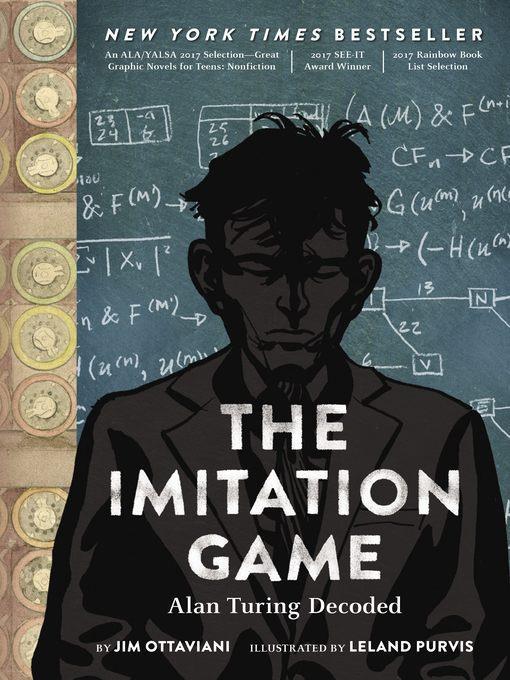
The Imitation Game
Alan Turing Decoded
فرمت کتاب
ebook
تاریخ انتشار
2016
Lexile Score
550
Reading Level
2-3
ATOS
4.3
Interest Level
9-12(UG)
نویسنده
Leland Purvisناشر
ABRAMSشابک
9781613129319
کتاب های مرتبط
- اطلاعات
- نقد و بررسی
- دیدگاه کاربران
نقد و بررسی

February 1, 2016
A powerful, sympathetic portrait of one of the 20th century’s great minds, this graphic biography of Alan Turing doesn’t play the usual game of establishing its hero as the only smart person in the room. Here, the great brain of Bletchley Park was just one of many odd geniuses (albeit possibly the most innovative) who helped crack the Nazis’ seemingly unbreakable Enigma code machine. Writer Ottaviani (Feynman) threads the particulars of Turing’s life, from school to top-secret wartime cryptography to postwar scandal. But the book’s thought-provoking core is Turing’s pursuit of his groundbreaking idea of the universal computer and using his imitation game (a method of telling artificial intelligence from the real thing) to plumb the corners of his own personality. Purvis’s sometimes-clunky art suggests a more juvenile volume than is actually delivered in this fully three-dimensional portrait of a man whose contributions—to the modern world as well as the war—was only recognized long after his tragic disgrace.

April 1, 2016
Gr 9 Up-British scientist and mathematician Alan Turing pioneered theoretical computer science and artificial intelligence during the first half of the 20th century. Like many geniuses, he was misunderstood by most of his peers, and he was eventually ostracized because of his sexuality. Regardless, his work was instrumental in ending World War II as well as in revolutionizing computer science. This adaptation uses a pastel palette of watercolors, strong black lines, and dynamic storytelling devices to bring Turing's tale to life. Multiple narratives, including those of Turing, his mother, and several of his colleagues and friends, weave in and out, following Turing from adolescence to the end of his short life. Readers not familiar with the man may be confused by the multiple narrators, who are not clearly identified. Others will enjoy the mystery and putting the puzzle pieces together until a clearer picture of Turing is formed. Teens with math or computer science bent will enjoy this slice of history and will learn about logic and algorithms along the way. Those who are interested in social justice and LBGTQ rights will also be engaged. VERDICT While this graphic novel will appeal to a broad range of readers, the technical language describing Turing's work may dissuade some. An additional, although worthwhile, purchase.-Tamara Saarinen, Pierce County Library, WA
Copyright 2016 School Library Journal, LLC Used with permission.

May 15, 2016
The secret that earned Alan Turing (1912-54) an Order of the British Empire--that his cryptographic assistance shortened World War II by years--couldn't be revealed during his lifetime. But the secret that brought his tragic disgrace--his homosexuality--he naively admitted to the British police, and it was publicized widely by the press. Ottaviani's (Feynman) three-dimensional portrait departs from the similarly titled film in painting Turing as a brilliantly eccentric yet social fellow, with friends and pastimes. His so-called "imitation game" turned on whether a man can be taken for a woman or vice versa--and whether a machine can be taken for a human. Voice-overs supply viewpoints from Turing himself and people who knew him, providing both technical and lay accounts of his accomplishments in mathematics, code breaking, and artificial intelligence. Purvis (Suspended in Language) excels with the numerous characters in a basic yet approachable style, depicting Turing's youth in lighter watercolorlike tones and his adulthood with more intense hues. VERDICT Those drawn to Turing's story through the movie as well as others curious about the history of computing will find this nuanced treatment compelling.--MC
The secret that earned Alan Turing (1912-54) an Order of the British Empire--that his cryptographic assistance shortened World War II by years--couldn't be revealed during his lifetime. But the secret that brought his tragic disgrace--his homosexuality--he naively admitted to the British police, and it was publicized widely by the press. Ottaviani's (Feynman) three-dimensional portrait departs from the similarly titled film in painting Turing as a brilliantly eccentric yet social fellow, with friends and pastimes. His so-called "imitation game" turned on whether a man can be taken for a woman or vice versa--and whether a machine can be taken for a human. Voice-overs supply viewpoints from Turing himself and people who knew him, providing both technical and lay accounts of his accomplishments in mathematics, code breaking, and artificial intelligence. Purvis (Suspended in Language) excels with the numerous characters in a basic yet approachable style, depicting Turing's youth in lighter watercolorlike tones and his adulthood with more intense hues. VERDICT Those drawn to Turing's story through the movie as well as others curious about the history of computing will find this nuanced treatment compelling.--MC
Copyright 2016 Library Journal, LLC Used with permission.

March 15, 2016
Ottaviani is well known for his graphic biography of Richard Feynman (Feynman, 2011), and here he turns his attention to another giant of science: Alan Turing. In a kind of disembodied interview, Turing's words appear in conversation with his friends, colleagues, and family, all of whom appear in muted gray tones suggestive of the afterlife. Interspersed with these remembrances are colorful scenes of Turing's life, from his childhood struggles in school to his groundbreaking research in mathematics and computing to his top-secret work at Bletchley, all culminating in his infamousand recently contested, as noted in Ottaviani's afterworddeath by cyanide poisoning. Purvis' naturalistic watercolor art makes pleasant work of Ottaviani's script, even in moments where the bulk of the action is talking heads. Most heartbreaking, of course, is the depiction of the lead-up to Turing's indecency trials, during which the hapless obliviousness to consequence that so charmed his colleagues bore terrible fruit in his personal life. This moving, sensitive account artfully balances conveying both the life and the pioneering discoveries of a fascinating, vitally important scientist.(Reprinted with permission of Booklist, copyright 2016, American Library Association.)

























دیدگاه کاربران